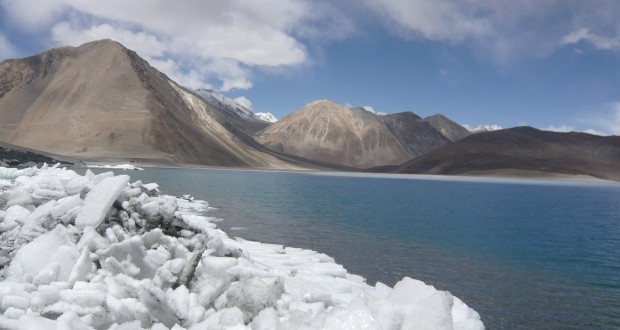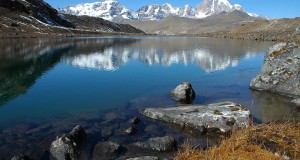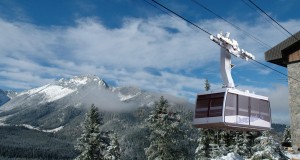Darjeeling is a large, widely-dispersed complex of steep steps, deep declines, heaped buildings and winding streets, few of which are properly sign–posted, strung out over a wide ridge like a flattened, many-tiered, 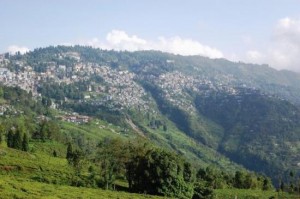 wedding cake. As with Shimla, it takes days to figure out. Everywhere you go in Darjeeling is either a long way up, or a long way down, but the scenery takes your mind off the slog. There are some really pleasant walks in this area, though if you don’t feel like the exercise you can hire taxis, jeeps and landrovers from the Tourist Bureau, or pick up a pony from Chowrasta square.Orientation in Darjeeling is difficult and maps don’t really help. A useful landmark is the small Lion’s Club traffic island, on the town’s top level. The taxi-rank is here, and it’s a popular pick-up/drop point for buses to/from Calcutta /Bagdogra. The island sits at the junction of Nehru Road, leading up the hill to Glenary’s restaurant, Tourist Bureau and Chowrasta, and Laden-La Rd which leads down the hill to Himalaya restaurant, Shamrock Lodge, and post office. Going down the steep steps behind Himalaya Restaurant, and heading right, takes you to New Dish restaurant on J.P. Sharma Rd. Just up from New Dish, a steep road leads down for Hill Cart Rd and the
wedding cake. As with Shimla, it takes days to figure out. Everywhere you go in Darjeeling is either a long way up, or a long way down, but the scenery takes your mind off the slog. There are some really pleasant walks in this area, though if you don’t feel like the exercise you can hire taxis, jeeps and landrovers from the Tourist Bureau, or pick up a pony from Chowrasta square.Orientation in Darjeeling is difficult and maps don’t really help. A useful landmark is the small Lion’s Club traffic island, on the town’s top level. The taxi-rank is here, and it’s a popular pick-up/drop point for buses to/from Calcutta /Bagdogra. The island sits at the junction of Nehru Road, leading up the hill to Glenary’s restaurant, Tourist Bureau and Chowrasta, and Laden-La Rd which leads down the hill to Himalaya restaurant, Shamrock Lodge, and post office. Going down the steep steps behind Himalaya Restaurant, and heading right, takes you to New Dish restaurant on J.P. Sharma Rd. Just up from New Dish, a steep road leads down for Hill Cart Rd and the 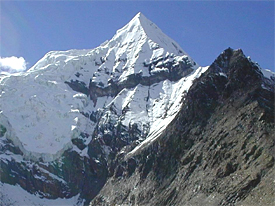 bazaar. Directly above the Lion’s Club island (look out for Dekavas restaurant), Gandhi Rd leads off to Oberoi/Springburn hotels and the Tibetan/Japanese monasteries. The steep hill road going down from the traffic island, parallel to the taxi-rank, is the quick way to the bazaar.
bazaar. Directly above the Lion’s Club island (look out for Dekavas restaurant), Gandhi Rd leads off to Oberoi/Springburn hotels and the Tibetan/Japanese monasteries. The steep hill road going down from the traffic island, parallel to the taxi-rank, is the quick way to the bazaar.
Hardly anyone sightsees the first day here. The cool, crisp mountain air and the altitude makes most newcomers feel lethargic. After settling in, allow yourself 3 clear days to cover the main interest spots. Conducted tours are offered by the Tourist Bureau, but be warned, all sightseeing here is arduous. The walks suggested below cover the central, west and east sections of Darjeeling, and can be done in any order, though you should visit Tiger Hill at the very first sign of clear weather, to get the mountain views. All three walks take the Tourist Bureau, Chowrasta, as their starting point.
Walk One (on foot, 5/6 hours)
Natural History Museum-Botanical Gardens-Victoria Falls-Art Gallery-Tenzing’s House
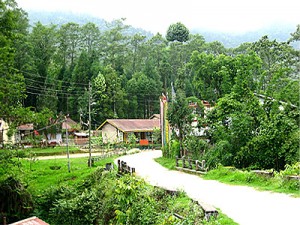 Coming up Nehru Rd to Chowrasta square, turn left for the Bengal Natural History Museum in Meadowbank Road. This was set up in 1903 to give visitors some idea of the wildlife of the district, and houses a comprehensive collection (4300 exhibits) of pattern-board butterflies and insects, hang-gliding Himalayan squirrels, worthy stuffed tigers and buffaloes, and an Indian elephant (tusks and legs only). It’s an interesting display, very well-presented and describing mainly the fauna of Darjeeling, Sikkim, Tibet, Bhutan, Nepal and the Eastern Himalaya. Admission is Rsl, and it’s open 10 am-4 pm (Wednesday 1-4 pm, closed Thursday).
Coming up Nehru Rd to Chowrasta square, turn left for the Bengal Natural History Museum in Meadowbank Road. This was set up in 1903 to give visitors some idea of the wildlife of the district, and houses a comprehensive collection (4300 exhibits) of pattern-board butterflies and insects, hang-gliding Himalayan squirrels, worthy stuffed tigers and buffaloes, and an Indian elephant (tusks and legs only). It’s an interesting display, very well-presented and describing mainly the fauna of Darjeeling, Sikkim, Tibet, Bhutan, Nepal and the Eastern Himalaya. Admission is Rsl, and it’s open 10 am-4 pm (Wednesday 1-4 pm, closed Thursday).
Proceed on down Meadowbank Road, left into Cutcherry Road, and down into the main Cart Road. Ten minutes’ walk to the left brings you to Lloyds Botanical Gardens, situated just below the Market Motor Stand. Opened in 1865, these pretty, peaceful gardens contain a representative collection of flora of the Sikkim Himalaya. The charming terrace has alpine plants, arum-lilies, geraniums, azaleas, rhododendrons, tree ferns and various conifers. There is a spacious Orchid House containing over 2000 different species of orchid and a herbarium. The hothouses are supposed to be a feature, but out of season contain just a few primulas, polyantha and cacti locked away under 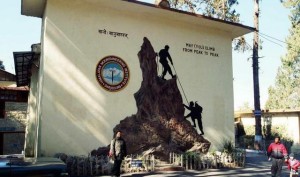 heavy guard. Open 6 am-5 pm daily; closed Sundays, admission free.
heavy guard. Open 6 am-5 pm daily; closed Sundays, admission free.
Take directions to leave the gardens into Victoria Road (south exit), and proceed left on a pleasant half-hour hike down to Victoria Falls. The falls themselves are often just a muddy stream running over an incredibly steep precipice (they only come into their own in the October/November post-monsoon season) but the walk is one of the most pleasant in the area. A short distance further down Victoria Road, turn up left into Uday Chand Road, then Cart Road. Just to your right is the Ava Art Gallery (tel 2469). This houses a fine exhibition of art and embroidery work belonging to Mrs Ava Devi. Open 8 am-noon, 12.30-6.30 pm; admission Rsl. Opposite the gallery, five minutes up D.B. Gird Road, finish off with a visit to Tenzing’s House, the home of the famous mountaineer, before returning via the long Gandhi Road to the Tourist Office.
Walk Two (on foot, full-day)
Tea Gardens-Mountaineering Institute-Zoological Park-Passenger Ropeway-Tibetan Refugee Centre
Proceed down by the Cart Road, and follow the road signed ‘Ropeway’ leading off top of Chowrasta Square to the Happy Valley Tea Gardens, 3 km (2 miles) from the centre of town. The entrance is near the intersection of T.B. 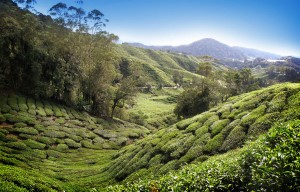 Banerjee Road, left off Cart Road, and Pamphawat Gurungni Road. It’s best to arrive here early, since a full half-day is needed to tour the estate. Happy Valley is open 8–noon, 1-4.30 pm except Mondays, and Sunday afternoons. Of the 70 or so tea gardens in this hill region, this is one of the nearest to town. It still produces tea by the orthodox method, whereby the fresh tea leaves are placed in a withering trough and dried out with high-velocity fans, then successively rolled, pressed and carefully fermented on a conveyor belt. After a last drying process, the tea is sorted into grades of Golden Flowery Orange Pekoe (unbroken leaves), then Golden Broken Orange Pekoe, Orange Fannings and Dust (broken leaves).
Banerjee Road, left off Cart Road, and Pamphawat Gurungni Road. It’s best to arrive here early, since a full half-day is needed to tour the estate. Happy Valley is open 8–noon, 1-4.30 pm except Mondays, and Sunday afternoons. Of the 70 or so tea gardens in this hill region, this is one of the nearest to town. It still produces tea by the orthodox method, whereby the fresh tea leaves are placed in a withering trough and dried out with high-velocity fans, then successively rolled, pressed and carefully fermented on a conveyor belt. After a last drying process, the tea is sorted into grades of Golden Flowery Orange Pekoe (unbroken leaves), then Golden Broken Orange Pekoe, Orange Fannings and Dust (broken leaves).
Next visit the Himalayan Mountaineering Institute (tel 2438), on Jawahar Road West, some 10 minutes’ walk down Pamphawat Gurungni Road (left out of the tea gardens), keeping to the right-hand side of the road. This unique institute, which exists to train mountaineers, has a marvellous museum (open 9 am-4.30 pm daily, closed Tuesdays in winter) full of photos, exhibits, and equipment relating to past mountaineering expeditions. The institute itself is open 10 am-1 pm, 1.30 pm-4 pm except Sundays, and Saturday afternoons.
The adjoining Zoological Park is a real anomaly. Its novelty value as a ‘high 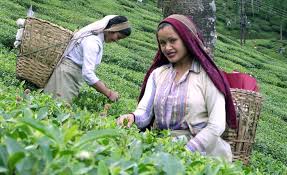 altitude wildlife park’ is spoilt by the quite awful conditions in which its animals, mostly Siberian tiger, Himalayan black bear, deer, panda and birds are kept. Even the prime exhibits, a beautiful snow leopard and red pandas, are not exempt. The anomaly is that the animals seem so happy, apparently thriving within their tiny, dirty little cages. Wildlife buffs and conservationists come away totally mystified.
altitude wildlife park’ is spoilt by the quite awful conditions in which its animals, mostly Siberian tiger, Himalayan black bear, deer, panda and birds are kept. Even the prime exhibits, a beautiful snow leopard and red pandas, are not exempt. The anomaly is that the animals seem so happy, apparently thriving within their tiny, dirty little cages. Wildlife buffs and conservationists come away totally mystified.
On the way to the Mountaineering Institute from the Tea Gardens, one interesting possible diversion, for which you will need to take directions, is a visit to the tomb of Alexander Koros . This famous 19th-century Hungarian orientologist travelled to Darjeeling determined to prove that the Tibetan and Hungarian peoples shared a common root-race origin. His lasting monument was a dictionary and grammar of the Tibetan language. He died on the way to Lhasa in 1842, and was buried here at Darjeeling. His tomb, now a national monument, is in the cemetery.
A short distance right, out of the Mountaineering Institute, at North Point, is Darjeeling’s famous Passenger Ropeway. The first passenger ropeway to be constructed in India, it is 8 km (5 miles) long and connects Darjeeling 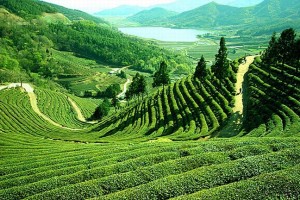 with Singla Bazaar, a beautiful picnic and fishing spot at the bottom of the valley. It’s a lovely excursion, as long as you have a head for heights, and the perfect way of finishing off the day. Unfortunately, the ropeway is often closed for repairs. When fixed, it’ll probably only be going down as far as Tukbar Tea Estate.
with Singla Bazaar, a beautiful picnic and fishing spot at the bottom of the valley. It’s a lovely excursion, as long as you have a head for heights, and the perfect way of finishing off the day. Unfortunately, the ropeway is often closed for repairs. When fixed, it’ll probably only be going down as far as Tukbar Tea Estate.
If you still have time, call in on the Tibetan Refugee Self-help Centre (closed Sunday) a sturdy half-hour trek back towards town along the Lebong Cart Road. Established in 1959 to rehabilitate displaced Tibetans who had followed the Dalai Lama to India, this large, very well-organised centre produces marvellous carpets, woollens, leatherwork, wood carvings and Tibetan curios and jewellery. Prices tend to be fixed, but bargaining with the friendly, hospitable Tibetan people is always fun. So is watching them at work weaving their carpets and making handicrafts. From here (take directions where you can find them!) it’s a stiff, demanding half-hour climb back up to Chowrasta square.
Walk Three (by jeep/on foot, half-day)
Tiger Hill–Ghoom Monastery
Situated 11 km (7 miles) out of Darjeeling town, at an altitude of 2610 m, Tiger Hill is internationally famous for its dawn views over Mount Kanchenjunga and the great eastern Himalayan peaks, including Mt Everest.
Sightseeing buses and private jeeps ply up there each morning, but are unsatisfactory: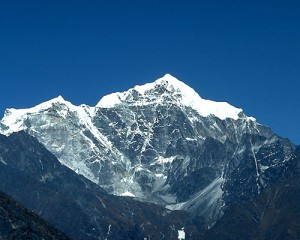 you have to get up at 4 am, and you travel there and back in a horrid, noisy convoy of other tour vehicles. This is one trip to do completely on your own initiative_ Set aside a full day, and stay overnight at the pleasant Tiger Hill Tourist Lodge with Rs20 dorm beds and rooms from Rs100 (tel 2813 to advance-book). This simple but friendly lodge is beautifully situated on a scenic plateau facing directly on to Kanchenjunga.
you have to get up at 4 am, and you travel there and back in a horrid, noisy convoy of other tour vehicles. This is one trip to do completely on your own initiative_ Set aside a full day, and stay overnight at the pleasant Tiger Hill Tourist Lodge with Rs20 dorm beds and rooms from Rs100 (tel 2813 to advance-book). This simple but friendly lodge is beautifully situated on a scenic plateau facing directly on to Kanchenjunga.
Set off early in the afternoon, taking a jeep to Ghoom from the rank at the bottom of Laden-La Road (regular departures but generally crowded). Alighting at Ghoom’s Jore Bungalow, start up the hill road rising above the train track. A couple of minutes walk up this road, strike left up the narrow, high path leading up to a small Buddhist temple; this is a short cut, taking you along the mountain ridge all the way up to Tiger Hill Lodge in 1 hour—far better than the dull 2/3 hour slog up the main road. The views along the ridge are spectacular: deep, dipping valleys of conifer, magnolia and rhododendron, against a dramatic mountain backdrop.
When dining at the lodge where they serve good thali suppers, request an earlymorning call.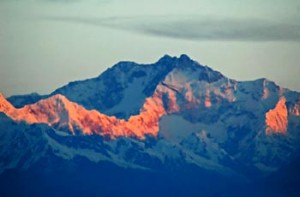 You’ll need to rise a good hour before dawn. In the lodge, have a flashlight handy since there’s often no electricity at night. Dress warmly, it can get very cold.
You’ll need to rise a good hour before dawn. In the lodge, have a flashlight handy since there’s often no electricity at night. Dress warmly, it can get very cold.
In the morning, it’s a stiff, steep 30-minute ascent up to Tiger Hill viewpoint. Walking up the dark road, keep your flashlight waving all the time, to avoid being mown down by fleets of tour buses and jeeps tearing up the highway. If exhausted, remember the big advantage of walking it to the top is that you arrive warm. Everyone else freezes solid.
The sunrise at Tiger Hill is spectacular. The massive peak of Kanchenjunga rears up flanked by Kabru and Pandim. To the far left, the central of three distant peaks, is Everest, surrounded by Markalu, Lhotse and several other summits. The observation point is swarming with Indian and Nepali tourists, all busily taking photographs. Before descending, call in on the small Shiva shrine just below. It’s a charming little place, set on a small plateau in deep woodland, full of Buddhist prayer-flags and rows of tiny Shiva tridents decked with red arm-bangles. Return to the lodge along the hill path running above the busy main road swarming with departing tour buses. Back at the lodge, take breakfast, and return down the short-cut hill path to the Jore Bungalow (40 minutes).
The next stop is Ghoom Buddhist Monastery. lust right of the lore Bungalow, turn left up Ghoom Monastery Road (signed–posted), and pass through the small, colourful village until some 10 minutes later you reach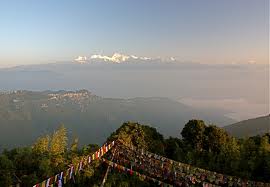 the open-air corridor of fluttering Buddhist prayer-flags which announce your arrival at the monastery. Ghoom Monastery is the oldest and most famous monastery in Darjeeling. Established in 1850 by a famous Mongolian astrologer-monk, it belongs to the Yellow Sect and houses a massive image of Maitreya (the ‘Buddha to Come’). He sits in the dusty, atmospheric inner shrine, surrounded by flags, bells, drums and stacks of prayerstools. A single beam of light from a ceiling window cuts through the gloom. It’s the nearest thing to Tibet you’ll see without actually going there. A small donation is customary, and there’s a stiff Rs10 charge for each photo taken.
the open-air corridor of fluttering Buddhist prayer-flags which announce your arrival at the monastery. Ghoom Monastery is the oldest and most famous monastery in Darjeeling. Established in 1850 by a famous Mongolian astrologer-monk, it belongs to the Yellow Sect and houses a massive image of Maitreya (the ‘Buddha to Come’). He sits in the dusty, atmospheric inner shrine, surrounded by flags, bells, drums and stacks of prayerstools. A single beam of light from a ceiling window cuts through the gloom. It’s the nearest thing to Tibet you’ll see without actually going there. A small donation is customary, and there’s a stiff Rs10 charge for each photo taken.
If it’s running, return to Darjeeling by the toy train. There are usually regular departures from Ghoom station, 5 minutes’ walk above Jore Bungalow. Even if the train is out of commission, enjoy strange station signs like ‘Don’t be afraid of Unnecessarily. Keep a strict watch around yourself.’ The ride itself is a short, scenic half-hour ‘taster’ of the miniature railway, an ideal compensation for those who came up to Darjeeling by bus or jeep.

